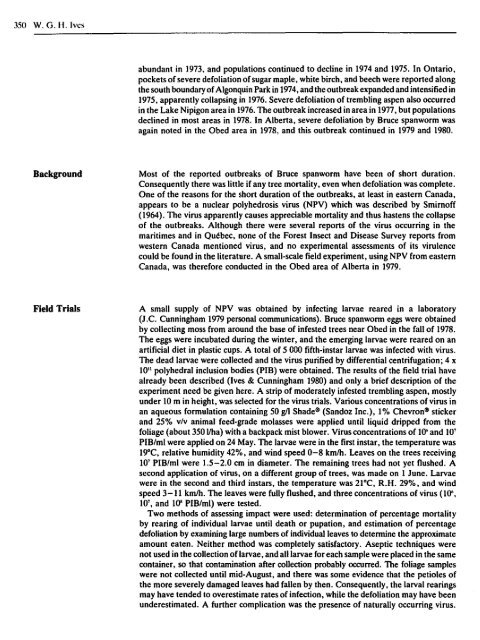pdf, 57.71Mb - Entomological Society of Canada
pdf, 57.71Mb - Entomological Society of Canada
pdf, 57.71Mb - Entomological Society of Canada
You also want an ePaper? Increase the reach of your titles
YUMPU automatically turns print PDFs into web optimized ePapers that Google loves.
350 W. G. H. Ivcs<br />
Background<br />
Field Trials<br />
abundant in 1973. and populations continued to decline in 1974 and 1975. In Ontario,<br />
pockets <strong>of</strong> severe defoliation <strong>of</strong> sugar maple, white birch, and beech were reported along<br />
the south boundary <strong>of</strong> Algonquin Park in 1974, and the outbreak expanded and intensified in<br />
1975, apparently collapsing in 1976. Severe defoliation <strong>of</strong> trembling aspen also occurred<br />
in the Lake Nipigon area in 1976. The outbreak increased in area in 1977, but populations<br />
declined in most areas in 1978. In Alberta, severe defoliation by Bruce spanworm was<br />
again noted in the Obed area in 1978, and this outbreak continued in 1979 and 1980.<br />
Most <strong>of</strong> the reported outbreaks <strong>of</strong> Bruce spanworm have been <strong>of</strong> short duration.<br />
Consequently there was little if any tree mortality, even when defoliation was complete.<br />
One <strong>of</strong> the reasons for the short duration <strong>of</strong> the outbreaks, at least in eastern <strong>Canada</strong>,<br />
appears to be a nuclear polyhedrosis virus (NPV) which was described by Smirn<strong>of</strong>f<br />
(1964). The virus apparently causes appreciable mortality and thus hastens the collapse<br />
<strong>of</strong> the outbreaks. Although there were several reports <strong>of</strong> the virus occurring in the<br />
maritimes and in Quebec, none <strong>of</strong> the Forest Insect and Disease Survey reports from<br />
western <strong>Canada</strong> mentioned virus, and no experimental assessments <strong>of</strong> its virulence<br />
could be found in the literature. A small-scale field experiment, using NPV from eastern<br />
<strong>Canada</strong>, was therefore conducted in the Obed area <strong>of</strong> Alberta in 1979.<br />
A small supply <strong>of</strong> NPV was obtained by infecting larvae reared in a laboratory<br />
(J.c. Cunningham 1979 personal communications). Bruce spanworm eggs were obtained<br />
by collecting moss from around the base <strong>of</strong> infested trees near Obed in the fall <strong>of</strong> 1978.<br />
The eggs were incubated during the winter, and the emerging larvae were reared on an<br />
artificial diet in plastic cups. A total <strong>of</strong> 5 000 fifth-instar larvae was infected with virus.<br />
The dead larvae were collected and the virus purified by differential centrifugation; 4 x<br />
1011 polyhedral inclusion bodies (PIB) were obtained. The results <strong>of</strong> the field trial have<br />
already been described (Ives & Cunningham 1980) and only a brief description <strong>of</strong> the<br />
experiment need be given here. A strip <strong>of</strong> moderately infested trembling aspen, mostly<br />
under 10 m in height, was selected for the virus trials. Various concentrations <strong>of</strong> virus in<br />
an aqueous formulation containing 50 gil Shade® (Sandoz Inc.), 1 % Chevron® sticker<br />
and 25% v/v animal feed-grade molasses were applied until liquid dripped from the<br />
foliage (about 350 lIha) with a backpack mist blower. Virus concentrations <strong>of</strong> 10' and 10'<br />
PIB/ml were applied on 24 May. The larvae were in the first instar, the temperature was<br />
19°C, relative humidity 42%, and wind speed 0-8 kmlh. Leaves on the trees receiving<br />
10' PIB/ml were 1.5-2.0 em in diameter. The remaining trees had not yet flushed. A<br />
second application <strong>of</strong> virus, on a different group <strong>of</strong> trees, was made on 1 June. Larvae<br />
were in the second and third instars, the temperature was 21°C, R.H. 29%, and wind<br />
speed 3-11 kmlh. The leaves were fully flushed, and three concentrations <strong>of</strong> virus (IO',<br />
10', and 10' PIB/ml) were tested.<br />
Two methods <strong>of</strong> assessing impact were used: determination <strong>of</strong> percentage mortality<br />
by rearing <strong>of</strong> individual larvae until death or pupation, and estimation <strong>of</strong> percentage<br />
defoliation by examining large numbers <strong>of</strong> individual leaves to determine the approximate<br />
amount eaten. Neither method was completely satisfactory. Aseptic techniques were<br />
not used in the collection <strong>of</strong> larvae, and all larvae for each sample were placed in the same<br />
container, so that contamination after collection probably occurred. The foliage samples<br />
were not collected until mid-August, and there was some evidence that the petioles <strong>of</strong><br />
the more severely damaged leaves had fallen by then. Consequently, the larval rearings<br />
may have tended to overestimate rates <strong>of</strong> infection, while the defoliation may have been<br />
underestimated. A further complication was the presence <strong>of</strong> naturally occurring virus.
















